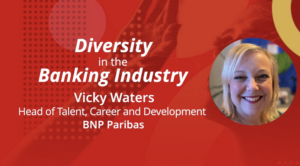Understanding D&I: The shortest distance between two people is a story
- 6 Min Read
Wendy Dailey explores the importance of stories and true connections in cultivating truly meaningful diversity and inclusion initiatives in the workplace.
- Author: Wendy Dailey
- Date published: Sep 19, 2019
- Categories

Every Christmas season we watch a variety of versions of “A Christmas Carol.” The George C Scott version is the perennial favorite. My favorite scenes are with the Ghost of Christmas Present because that’s when Ebenezer starts to really get it. I wrote more about this when I shared our #HRWonderWomen episode with Elena Valentine.
You can see the light come on. It’s Tiny Tim’s story, Bob Cratchit’s story that brings the glimmer of understanding. Because Ebenezer finally sees Bob as a person, not just an employee.
And that’s what it takes — that small glimmer of understanding. It is so easy to fall into the us vs them, to think of another group as an “other” “different.” We are programmed to see Others as a threat and it is easier to dehumanize a group than an individual. Which is why the individual stories are so important.
As we learn about people, we need to step away from past habits. For years, we were told to not “notice” race. When we heard to not judge someone by the color of their skin, we took it literally and decided it was rude to describe someone by their race or their gender. How many times, in HR, do we hear, “I just want the best person for the job.” And how often does the best person for the job look like you?
This is where Diversity & Inclusion come into play in our organizations. We use diversity to measure the who we are bringing into our organization. We’ve all heard the research – the more diverse your workforce, the more successful you will be. The ROI on diversity is clear. The issue we end up having is keeping the diversity. That’s inclusion. We need to ensure the workforce we bring in feels like a part of the team, like they are important, so they stay. The struggle is how. Most of the time when we talk about diversity and inclusion, we talk about the numbers, the ROI, the why. We don’t spend a lot of time on the how.
I believe we need to spend more time on the how, on ensuring all staff feel welcomed and included. I was listening to Sarah Morgan’s podcast “Leading in Color” when she talked to Stephanie Ghoston-Paul. Stephanie said something that stuck with me “When we take care of those on the margins, we take care of everybody.” If those on the margins feel welcomed, feel part of the team, everyone else will as well.
The very first thing you need to do is make certain your organization is prepared to be inclusive. Is your culture ready to bring in people who look different or even don’t fit the traditional “mold” of who normally joins? You start with diversity training, but it goes beyond the one and done training.
Part of that is understanding your story and how you view other’s stories. You need to know your own lens through which you see the world, which is why sharing how we identify is so important. When I share that I am a white, straight, cis-gender, non-disabled female, it might feel odd or even silly at first. Do we need to share what is obvious or “normal”? Yes. When we share our stories, people learn who we are which makes them comfortable to share theirs.
Sharing stories builds trust, because sharing stories is being vulnerable. When we are vulnerable, when we build trust, we can have true inclusion. But it’s just the start. The good news is it’s actually pretty easy to continue to build the relationship. By looking at what employees want, we can build an inclusive environment for all of us.
You need to start with you. You need to be the example in sharing stories. You can’t expect your people to be comfortable sharing themselves if you aren’t sharing yourself. You need to share the obvious. You need to embrace feeling uncomfortable with sharing your pronouns, how you wish to be addressed. When you get uncomfortable, then you can get real. Only then will get staff to feel comfortable in sharing who they are. But you need to be patient because it won’t happen the first time out.
Once you know who your staff is, then you can move into a few other easy ways to encourage inclusivity in your organization. To do that, you need to know what people really want. And this isn’t based on generations or diversity, but what all employees really want.
First, they want flexibility. Not work life balance. They want flexibility to be able to be a productive employee and live their best life. And that’s different for everyone. Which is why it’s important to know your employee, their needs, their wants. If you are flexible to allow an employee to leave early occasionally to get to their child’s school event or take their parent (or pet) to the doctor, they will be more likely to want to work a little hard, a little longer when you need them to. If you are counting every hour, rest assured, so are they.
They want their voices heard. Are your meetings productive? Are all voices heard? Who does most of the talking during your meetings? If it is you, perhaps you need to relook at what’s happening during your meetings. Share the agenda prior to the meeting and share a recap after. Many employees need time to process a meeting – what’s being discussed and what was discussed. You might just see more meeting participation if you give staff the time to think about what’s coming up. Ensure your staff understand that it is safe to share questions or comments outside of the meeting.
Finally, and most importantly, all employees want a strong relationship with their manager. This is why you share your story, so your employees understand who you are. They will be willing to share who they are, their goals if they know who you are. Coach your staff by giving and receiving actionable and honest feedback. Help your staff grow by setting clear expectations so they know how you define success for them. Champion your staff by giving them credit when deserved, find sponsor and mentor opportunities for your staff to help them grow. To help all staff, not just your “superstars.”
It’s not difficult to create an inclusive environment. You don’t need a complicated initiative, specialized groups. Each manager, each employee can take small steps to make all staff, or even just the next new employee who walks through the door, feel welcome and a part of the team.









